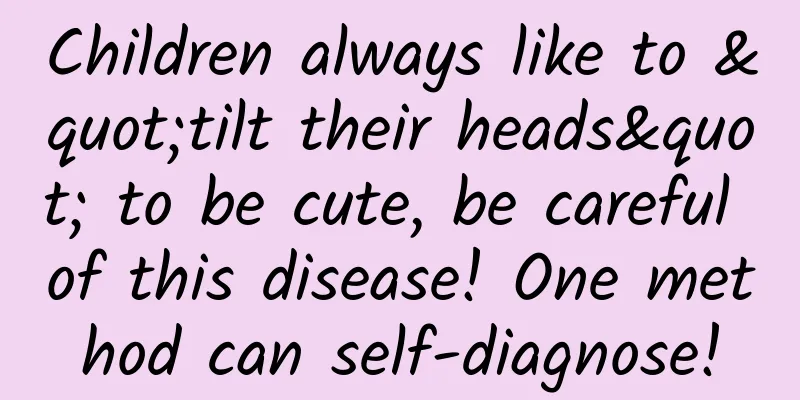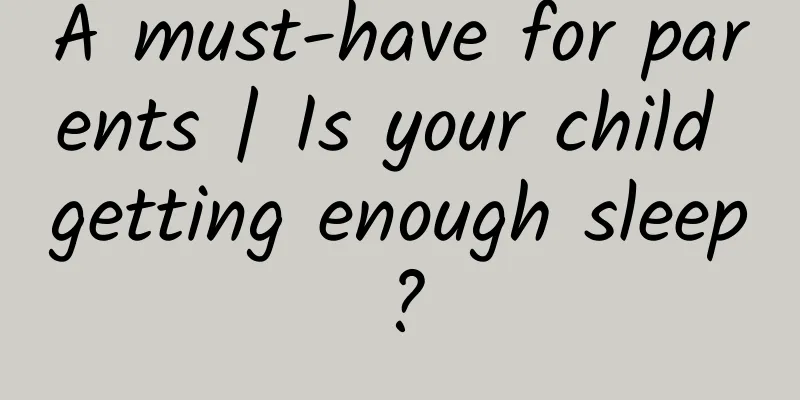Children always like to "tilt their heads" to be cute, be careful of this disease! One method can self-diagnose!

|
If a child tilts his head and squints his eyes, does that mean he has strabismus? Strabismus does not affect vision, can we wait until the child grows up before treating it? Is strabismus surgery a permanent solution? … Eyes are windows to the soul and an indispensable bridge for communication with the outside world. However, for children with strabismus, the road to communication with the world is somewhat tortuous. Strabismus is one of the most common eye diseases in children. It not only seriously affects the appearance and mental health of children, but may also have a serious impact on the mental health, visual function, visual development and even bone development of children. However, many people have many misunderstandings about strabismus, causing many children to miss the best time for treatment. Today, let's talk about children's strabismus and protect their eye health. Copyrighted stock images, reprinting and using may cause copyright disputes What is strabismus? Many parents find that their children like to tilt their heads or face sideways when watching TV, and they think their children have "strabismus" and come to see a doctor. After carefully examining the child, the ophthalmologist may tell the parents that "the child's eyes are not slanted." So what exactly is strabismus? Under normal circumstances, our eyes can complete coordinated movements under the control of the brain's higher centers and effectors (extraocular muscles), and focus on a target at the same time, so that the brain can perceive a complete three-dimensional image. If in some pathological cases, due to dysfunction of the brain's higher centers or abnormalities in the peripheral nerves that control the rotation of the eyeballs and the extraocular muscles on the surface of the eyeballs, the movement of the eyes loses balance, and the visual axes of the eyes are separated, causing one eye to focus on the target while the other eye deviates from the target. This phenomenon in which the two eyes cannot focus on the same target at the same time is called strabismus. How to determine whether a child has strabismus? How can parents easily determine whether their children have strabismus at home? Today, I will share with you a simple self-test method for families. The specific method is as follows: the parent and the child face each other, at a distance of about 33cm, holding a flashlight horizontally at the bridge of the child's nose between the eyes, and let the child stare at the flashlight. At this time, the flashlight will appear a reflective point on each of the child's eyes. Then see if the reflective spot is in the middle of the two eyeballs. If it is in the middle, then you can roughly judge that the child's eyes do not have obvious strabismus; if any of the reflective spots is on the inside, outside, or above or below the eyeball (in short, not in the middle), pay attention, the child may have strabismus. Of course, there are some special types of strabismus, and sometimes the reflection point of both eyes may be in the middle, such as accommodative esotropia, micro-strabismus, intermittent strabismus or rotational strabismus, etc. Therefore, if you suspect that your child has strabismus and you are unsure of the judgment, it is recommended that parents take their children to the hospital for examination in time. 3 common misconceptions about strabismus If a child tilts his head and squints his eyes, does that mean he has strabismus? Tilting your head to watch TV does not necessarily mean you have squinting. Under normal circumstances, no matter which direction we look, our eyes can always keep consistent. Strabismus means that the visual axes of the two eyes are not parallel. When looking at an object, one eye looks in the direction of the object, while the other eye does not look in this direction. This is true strabismus. Some children with strabismus have head tilt, also called compensatory head position, but some do not have head tilt, but simply have the binocular visual axes not parallel. So whether a child with head tilt has strabismus or not requires a professional strabismus doctor to make a judgment, because not all strabismus patients will have a tilted head to see things. Strabismus does not affect vision, can we wait until the child grows up before treating it? Some parents think that strabismus only affects appearance, and that the child is too young and surgery is risky, so they want to wait until the child is older before treating it. But in fact, strabismus not only affects appearance. If strabismus is not treated in time during the child's vision development, it will not only cause strabismic amblyopia, but also affect the development and establishment of normal binocular vision function. If the sensitive period of vision and visual development is missed, even if the eye position returns to normal after surgery, the visual function may not be restored. If children with strabismic amblyopia do not receive timely and effective treatment, their vision may not be fully restored, and they may even suffer from lifelong disability. Although there have been some improvements in the treatment of adult amblyopia, most of the results are still very poor. In addition, patients who have not recovered their binocular vision will have poor stereoscopic vision, which will limit their future career scope. For example, if they cannot perform microsurgery in our ophthalmology, they will not be able to become an ophthalmologist. To give another simple example, in our daily life, people without stereoscopic vision cannot see the 3D effect of the 3D movies we watch now. In addition, patients with poor binocular vision will have increased long-term eye position instability and a higher probability of recurrence of strabismus. Therefore, "waiting for the child to grow up before treatment" is not a very good decision. The timing of strabismus treatment, especially surgery, is very important and requires a comprehensive evaluation by a professional strabismus physician. Therefore, we still recommend that children with strabismus must be examined as early as possible and undergo professional evaluation. It is very important to choose the right time for treatment during follow-up. Is strabismus surgery a permanent solution? Surgery is an effective way to solve strabismus, and many strabismus can only be effectively solved through surgery, but strabismus surgery cannot completely solve the problem at once. When it comes to surgery, parents inevitably have many concerns and worries, and everyone's expectations for surgery are relatively high. Many parents believe that one surgery can solve the problem and hope that surgery can solve the problem once and for all, but this is not the case. First of all, it is sometimes impossible to completely solve the problem of strabismus surgery in one go. The strabismus surgeon will perform precise degree measurements and design the surgical plan before the operation, but due to individual differences and the complexity and unpredictability of some strabismus themselves, there are problems such as undercorrection, overcorrection, and recurrence after the operation. That is to say, a small number of children may have insufficient correction or overcorrection immediately after the operation; in addition, for children who have good correction effects in the early postoperative period, there is still the possibility of eye position changes during the postoperative recovery period, or after several years, due to changes in eye and physical conditions, strabismus may occur again. Therefore, after strabismus surgery, a small number of patients may face the problem of secondary surgery in the future. Reasons for reoperation of strabismus include residual or recurrence of the original strabismus (undercorrection), or the opposite strabismus (overcorrection). For example, some children with exotropia have a tendency to develop into a slight esotropia after surgery. We can actively take some non-surgical treatment measures, such as alternating occlusion and wearing appropriate glasses. Most children will recover after a period of treatment. If non-surgical treatment is ineffective, a second surgery is required. Another part of children with exotropia may have residual exotropia after surgery, or exotropia may recur within a period of time after surgery. If the angle of strabismus is large, another surgery may be required. In clinical work, a considerable number of children do not return for follow-up visits on time after surgery, which leads to some early problems that are not easy for parents to find. When the doctor sees the child again, some early treatment methods may no longer be effective. Therefore, it is very important to follow the doctor's instructions and return for follow-up visits on time after surgery. Secondly, there are some types of strabismus, such as the upper and lower strabismus mentioned earlier in this chapter. After surgical correction, the probability of unstable eye position is relatively high, and the possibility of strabismus change in the short or long term after surgery is relatively high. For example, before surgery, a child's right eye is higher than the left eye, and the head is tilted to the left shoulder. For a period of time after surgery, the eye position is normal and the head tilt is significantly improved. However, after half a year, the right eye becomes lower than the left eye, and the head becomes tilted to the right shoulder. At this time, it is possible to undergo another surgery. Finally, there is another situation that requires attention to the possibility of strabismus surgery again, that is, the situation where the vision of one or both eyes is significantly reduced. For example, a child's right eye was accidentally stabbed by scissors, and the vision was very poor. Later, strabismus gradually appeared. In order to correct the appearance, strabismus correction surgery was performed. Because the vision of the right eye was very poor, binocular single vision could not be established after the surgery. In this case, the probability of strabismus again will be relatively high. Of course, doctors have anticipated the above situations before surgery and will take them into consideration in the design of surgery to minimize reoperations. Strabismus surgery corrects the eye position, but normalization of the eye position does not mean that the visual function has also returned to normal. For children whose visual function does not recover well after surgery, the long-term instability of the eye position will increase, and the possibility of strabismus recurring will increase. Therefore, it is necessary for these children to undergo visual function rehabilitation training after surgery. Therefore, strabismus surgery is one of the main measures to treat most strabismus. It has a long history and is very mature. Most cases can achieve significant improvement after one surgery, but it is possible that some cases may require multiple surgeries. Strabismus surgery is not a one-time solution. After surgery, we may continue to perform related treatments or even perform another surgery based on the child's condition. "Stay Strabismus: How Much Do You Know About Strabismus and Amblyopia in Children" Strabismus and amblyopia seriously affect children's visual development and eye health. However, many parents lack medical knowledge about strabismus and amblyopia, and often ignore the timely diagnosis and treatment of strabismus and amblyopia in children, resulting in the harm of low vision accompanying children throughout their lives. The diagnosis and treatment of strabismus and amblyopia in children depends largely on the cognition and decision-making of parents. Therefore, it is urgent to vigorously strengthen the popularization of medical knowledge of strabismus and amblyopia, and there is still a long way to go. This book has 9 chapters, which describe the development process and laws of children's vision in easy-to-understand language and colorful illustrations, analyze the types of eye movement, the muscles and nerves that control the eyes, explain the causes, hazards, types and treatments of strabismus and amblyopia, and answer parents' and children's questions about the diagnosis and treatment of strabismus and amblyopia. This book aims to provide children, adolescents and parents with a way to understand the early detection, early diagnosis and treatment of children's strabismus and amblyopia, thereby improving the compliance and cooperation of diagnosis and treatment and obtaining the best treatment effect. Planning and production Source: Book "Don't Look Strabismus: How Much Do You Know About Strabismus and Amblyopia in Children", Science Popularization Press Planning丨Zhong Yanping Editor: Zhong Yanping Proofread by Xu Lailinlin |
>>: Summer heat stroke safety guide
Recommend
Girls' fitness exercises for buttocks
In our lives, many women put too much effort into...
What is abdominal ultrasound? What can it check?
Abdominal ultrasound is a commonly used medical i...
"Muscle" requires selective food, and there are rules for eating - dietary nutrition prevention and treatment strategies for sarcopenia
With the aging of the population becoming increas...
How to identify and relieve the symptoms of early rhinitis?
Rhinitis is a common disease. In addition to solv...
How often do you change your chopsticks? A truth that many people don’t know
How often do you change your chopsticks? It is ge...
What to do if you have a headache after washing your hair during menstruation
Many girls wash their hair every one or two days ...
How long does it take to rule out an ectopic pregnancy?
Ectopic pregnancy is very common. Women have to u...
What to do if a woman has jaundice
In life, many women have yellow leucorrhea. In fa...
How many weeks of pregnancy does it take to give birth
During pregnancy, many pregnant mothers pay great...
What are the consequences of ovarian removal?
Ovaries are also one of the female reproductive o...
Seven months pregnant, stomach discomfort after eating
During pregnancy, because the body of pregnant wo...
Is it necessary to have a confinement period after a caesarean section?
Cesarean section is a type of childbirth in which...
Medication for itching in female lower body
Women are a high-risk group for vaginitis. Data s...
What is the reason for black menstruation? Analysis of 3 common reasons
Black menstruation can scare women, which is main...
Bloody vaginal discharge after menstruation
Most female friends pay close attention to the co...









